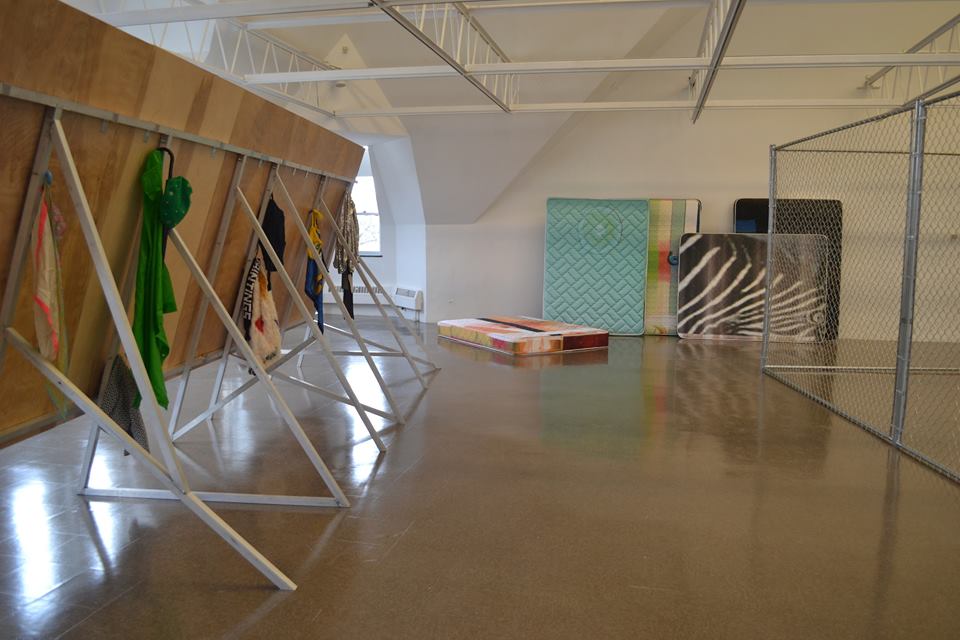
Teen Paranormal Romance” at the Renaissance Society, curated by Hamza Walker, explores a so-called unconscious surrealism similar to that of the young adult fiction genre that gives the exhibit its name. The art on display begs to be touched; most pieces are three-dimensional sculptures made of a variety of objects, ranging from industrial to ornamental to thrifted. These pieces hang on the wall, stand on the floor, or are stacked on top of each other. Poetry and art exist as found objects inside of “Teen Paranormal Romance,” both exuding the energy of the genre in its genesis of the new from the ubiquitous old.
Wade Guyton and Kelley Walker have created a multicolored set of mattresses, all titled “Mattress.” A chain-link fence traps two walls made of concrete bricks, each featuring a smiling bear cartoon, cordoning off the center of the gallery; this is Kathryn Andrews’ piece “Friends and Lovers.” A C.G.I. chimpanzee narrates Ed Atkin’s film “Even Pricks” located in a screening room adjacent to the main gallery. In this video, thumbs are inserted into ears and action movie previews are parodied.
Following the opening, artists Kathryn Andrews, Chris Bradley, Anna K.E., and Jack Lavender sat on a panel moderated by Walker to discuss assemblage, a type of art characterized by Andrews as the use and appropriation of the outside or pre-made in order to make something built and refined. “You strip the found and take from it what you want,” said Andrews.
Bradley’s pieces “Grease Face #3” and “#4” do just this. Faces are outlined by pushpins and plastic or by a bandsaw blade and framed by what seem to be the bottom halves of empty pizza boxes. There are visible lines where slices were cut from the pizzas, and speckles of the grease that once dripped from it. To my shock, Bradley told us that instead of using old Giordano’s boxes he created these boxes himself from steel and aluminum. “I want to learn the world through making,” he explained.
In Jack Lavender’s work “Hannah,” he attached fifteen seemingly random objects (including dried limes, sand in a bottle, and plastic peanuts) to crisscrossed and rusted steel rods, ignoring the readymade grid pattern in their arrangement. When asked about his reasons for choosing the media he works with, Lavender couldn’t explain exactly what it is that draws him to certain objects. “Something inside of them has a fetish quality,” Walker interjected.
This same explanation rings true for Anna K.E.’s sculpture “Lucky Weekend.” Her piece features white bathroom tiles with a brightly colored pyramid pattern of multi-shaped tiles on top, creating what she describes as a “pop art-ing of the minimalistic.” K.E. has a special connection to the media she uses: she was greatly influenced by the tile castles she visited with her grandmother in the former Soviet Union during her childhood. She also spoke of the relief bathrooms provided from social situations during her teenage years.
“Lucky Weekend” also features a poster that is covered up by a different poster every day, which K.E. describes as similar to the internet in its ephemerality and inability to be taken in completely. The back of the piece acts as a coat rack while displaying the metal tubing and wood that keeps the triangular prism-shaped sculpture standing. Through the collection of these readymade objects, something refreshing and expressive is created. The creation of these pieces doesn’t prompt them to speak directly to their audience—only interaction with the world allows for that. “Every damage becomes a history and a part of the body,” K.E. mused. “It becomes beautiful. It begins to breathe and communicate with you.”
Renaissance Society, 5811 S. Ellis Avenue, Fourth Floor. Through April 13. Tuesday-Friday, 10am-5pm; Saturday-Sunday, noon-5pm. (773)702-8670. renaissancesociety.org


